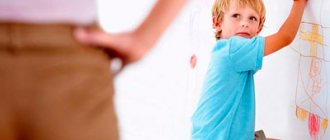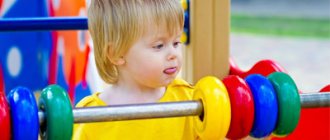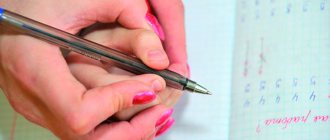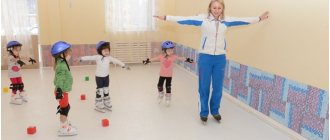In this article, I tried to collect the most important information about teaching swimming to preschoolers.
Attention! This article is about teaching swimming to young children, that is, between the ages of 3 and 5-6 years. If you are interested in teaching older children (6-10 years old), then follow this link, and if we are talking about kids, then here.
What can you really teach at this age?
Each child is individual, but in general, coaches consider the following:
- At 3 years old, most often the child is not yet developmentally ready to learn swimming, but he can begin to be taught basic skills that will be useful for swimming in the future.
- At 4 years old , a similar situation is possible, but many children at this age can already be taught swimming . However, we are not talking about the correct technique yet, that is, it is too early to talk about proper swimming in sports styles.
- At the age of 5 , a child can actually be taught to swim, including starting to learn the correct crawl technique (front and back) and breaststroke.
It is believed that at the age of five you can master a sports style in 2 months if you train 3 times a week for 30 minutes.
I repeat, all of the above is very conditional and depends on the development and abilities of the child. I admit that some unique people can learn to swim correctly in the front crawl or breaststroke even at 3-4 years old, although I myself have never seen this in person.
The main idea that I wanted to convey here is: do not have unreasonably high expectations, do not expect from a preschooler that at that age he will immediately swim with the correct technique and generally swim confidently.
However, at this age (from 4-5 years old) it is quite possible to teach how to float on the water and swim at least short distances, and also to lay the foundation so that at 6-7 years old he will already move on to confident and athletic swimming.
Attention! Rules for visiting the pool
Adults are required to wear replacement shoes and a hat. Our youngest guests from 0 to one and a half years swim STRICTLY in special disposable diapers for the pool.
The following information is required
- for your child - test results for worms and enterobiasis and a certificate from the pediatrician,
- for you - the results of tests for worms and enterobiasis and a certificate from a therapist.
The validity period of tests and certificates for both adults and children is 3 months.
We ask you to carefully monitor your children while swimming and take them to the toilet or potty on time; for the little ones, check their diapers. We monitor the purity of the water, so if the water is contaminated by your baby’s feces, be prepared to reimburse part of the costs for replacing the water and canceling other sessions. The amount of the fine is determined individually depending on the amount of the invoice issued by FOC Torpedo, approximately from 5 to 7 thousand rubles. According to sanitary rules, only swimwear and a change of shoes are allowed in the pool area. If there are a lot of spectators, we may ask them to leave - this is in the interests of your children.
Duration of class, including sauna - 45 minutes.
What to take with you to the pool in groups with parents:
- Certificates for everyone who enters the water (for an adult, permission from a therapist and test results for worm eggs and enterobiasis, for a child, permission from a pediatrician and results of tests for worm eggs and enterobiasis, the validity period for all certificates and tests is 3 (three) months);
- Receipt of payment (for the first lesson);
- Hats (except for babies with short hair);
- Swimming trunks/swimsuit/diaper-panties for swimming for babies;
- Flip flops;
- Towels;
Swimming is beneficial at any age. Doctors advise everyone to engage in this sport without exception; the aquatic environment helps not only maintain muscle tone, but also gives a good mood and increases endurance. There are many advantages to the activity; for children, the pool is a great way to have fun, improve their health, and for some it will help cope with diseases of the muscles and spine. Nurseries are located in many areas and offer a range of additional services, in addition to an activity track.
The most important principle of study
The second important thought, which I would also like to draw special attention to: the most important thing when learning to swim at this age is the child’s joy, interest, and positivity.
The fact is that swimming lessons should be systematic (one or two times is clearly not enough!), and a child at this age is not yet a fully formed, conscious personality and is not ready to systematically do something that he is not interested in or does not like.
Moreover, proper learning to swim (and you shouldn’t teach it incorrectly!) involves actions that are not very natural for a person, such as lowering your face and exhaling into the water .
The child may be afraid and not understand this and, ultimately, may decide that he “doesn’t need” all this at all.
Therefore, if you teach it yourself, I recommend taking into account the following:
- Learning must happen in a playful way in a light, relaxed manner. At a very young age and at first games are required.
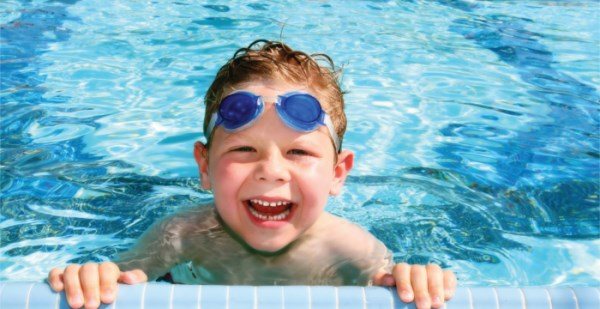
Joy is the main principle of classes - There should be no coercion or pressure .
If a child does not want to study, your task is to figure out how to interest him, make him want to study, but under no circumstances force him. Pedagogy is a subtle and controversial science, but I would not recommend giving a child gifts for classes . At least, definitely not for each lesson and not for the fact of the lesson itself. Think about how to make being in the water joyful and interesting - so that the child wants to be there, and not serve his “number” in order to receive a reward for suffering afterwards. Otherwise, you can spoil him and then end up in a very bad situation when he refuses to study without a gift. And the results of such activities will be worse than the results of activities that in themselves are pleasant and desirable for the child. - Praise him for his activities , even if there are no successes (and if there are successes, and for them separately). Don’t limit yourself to faceless phrases “well done,” but try to do it in more detail so that he feels that your words are not a formality.
- Be there in the water and show everything by personal example . Play, complete all the tasks yourself in parallel with the child, sometimes even in a competitive manner. Firstly, this way your tasks will be much more visual and understandable to him. Secondly, children often do not want to do what the parent himself did not do before.
- Do not throw your child into the water or do anything that might scare him!
- Don’t be afraid yourself – children can sense if a parent is afraid.
Pool exercises for young children
Children who regularly perform exercises in water get sick less and can more easily endure any stress . You can start swimming pool classes almost from the moment your baby is born. But even if your child did not go swimming during the infant period, it is useful to receive water treatments even after the first year of life.
It is only important to do this with a full understanding of the baby’s physiology. Let's look into it in detail.
Contents: Benefits of a swimming pool for children Contraindications and general recommendations for visiting a swimming pool Swimming pool for infants Swimming pool for a child 1.5-2 years old Exercises for children 2-3 years old Exercises for children 4-6 years old After exercises in the pool
Benefits of a swimming pool for children
Neurologists, orthopedists, immunologists, and pediatricians unanimously speak out about the benefits of water exercises for children , including infants.
Doctors' arguments about the benefits of swimming pools for children:
- Exercises in water help to quickly cope with neurological problems in infants.
- Exercises in water are an excellent conditioning for a young body.
- Swimming improves the functioning of the cardiovascular system and musculoskeletal system.
- A child who regularly attends swimming pool classes has stronger and more developed muscles.
- Children develop flexibility, which ensures their harmonious physical development.
- Swimming reduces aggression, as water helps relieve stress and relax.
- Swimming is one of the safest types of physical activity. The spine relaxes in water, which has a beneficial effect on its condition.
Good to know The most economical pools when taking into account parameters such as cost and volume are rectangular frame pools. For a dacha this is the best option.
Well, the most economical pools are homemade. And there is nothing overly complicated in their construction. Details are here.
Contraindications and general recommendations for visiting the pool
There are two options for a child to visit the pool:
1. Individual lessons with a trainer. Mom can be next to the child to encourage and entertain. For classes, a child will need a certificate from a pediatrician and a test for helminthiasis. The downside of this method is that not all children are ready to do exercises with a stranger; it takes time to adapt.
2. Group classes with one of the parents. The instructor directs the movements and gives recommendations, and the parent directly teaches swimming. For this option, you will need additional certificates for an adult (dermatologist, therapist and test for helminthiasis).
To visit the pool you must prepare the following supplies:
- close-fitting swimwear,
- special pants for babies,
- hat for an adult,
- soap,
- washcloth,
- towel,
- indoor shoes.
Despite the obvious benefits of swimming for children of any age, we must not forget about the existing contraindications . These include: 1. Viral infections and infectious skin diseases. 2. Diseases occurring in an acute form. 3. Heart and kidney failure. 4. Allergies, for example to chlorine. 5. Congenital heart defect, seizures. 6. Intestinal upset.
Infant pool
An aquatic environment is natural for infants, as the baby swam in amniotic fluid for nine months. It’s no wonder that three-month-old babies are amazed by their swimming abilities. start learning to swim at the age of three weeks . It is important that the umbilical wound heals . Getting acquainted with water should start with a bath; activities in the pool are recommended from the age of two months.
Exercises for infants:
1. Beginning of the lesson - vertical immersion in water. Lower and raise the baby several times.
2. The baby lies in the water on his tummy, and his parents gently support him by the chin. The body should be completely submerged in the water, with only the head on the surface.
3. The baby continues to lie on his tummy. A toy floats in front of him, he needs to try to catch up with it. “Let’s catch up with our boat, let’s sail faster.” Holding the baby by the chin, we catch up with the toy. The swimming speed gradually increases.
4. If the baby has already mastered direct swimming, it is worthwhile to diversify the activities. Holding the baby, begin to walk him in a circle, in a figure eight. Evaluate the baby’s reaction; if the baby likes it, the speed can be increased. Some children prefer a slow pace of movement.
5. We swim up to the side of the bathtub or pool and rest the child’s legs against it. The baby reflexively begins to push off, at this time you need to give a speech signal and swim.
6. Hold the child in the water by the chin and gently rock him. Back and forth. When moving forward, the body appears out of the water; when moving backward, it returns back.
Do you know that…
According to doctors, exercise in water has virtually no negative manifestations in the form of muscle strains, joint pain and other similar phenomena.
The next stage of teaching infants to swim is diving . It is recommended to carry it out under the supervision of an instructor, but you can start preparing yourself.
Diving training: 1. Give a speech signal: “Let's dive!” and blow lightly on the child’s face. The baby will close his eyes and hold his breath. The exercise must be repeated for 10 days.
2. We give a speech signal: “We dive!” and splash some water on your face, always from top to bottom. When the skill has been mastered, it is recommended to begin training in the pool under the guidance of a trainer.
Swimming pool for a child 1.5-2 years old
The exercises can be performed in the bathroom, but in a swimming pool there are more opportunities for proper execution.
1. The child sits on the side and actively begins to flop his legs. Another option is for parents to hold the baby on his stomach, and he actively moves his legs.
2. The child must collect the toys laid out at the bottom of the pool. In this case, the depth should be no higher than the baby’s chin. Exercise helps to cope with the fear of water. You can also help get rid of fear by lightly splashing water in the child’s face.
3. Holding the child by the body in the water, you need to rock him. The baby's legs are straight, they should not reach the bottom. Rocking allows the baby to feel that he can lie on the water and hold on.
4. Standing waist-deep in water, the child makes a boat with his hands and begins moving his arms to the sides. The baby can push the water back and forth.
5. We lower the child into the water and, holding his hands, begin to swing him in a circle or with a pendulum. This funny exercise can complete the complex or cheer up the baby when he is upset.
Exercises for children 2-3 years old
Children at this age are sometimes afraid of water, so you should not insist on exercises, but be patient . After an adjustment period, children will love the water and exercise . After two years, society and communication with other children are important for kids; you can organize group activities or a fun game in the water.
Exercises: 1. The child takes water into his hands and tries to hold it so that it does not flow away. You can put your face in the water and blow bubbles, while trying to get air and hold it.
2. Let the baby take in as much air as possible and try to blow on the water. Invite your little one to be the breeze or blow on an imaginary candle. You can blow on a toy in the water, driving it further and further into the distance.
3. Let the child pretend to be a small hippopotamus, plunging his head into the water, leaving only his eyes. You can depict a pelican catching a fish. The pelican lowers its head into the water and looks at the fish.
Good to know Of course, swimming is useful not only for children, but also for people of all ages. For example, we bring to your attention a set of exercises for losing weight in the pool. Try it!
Let’s also remember the benefits for the respiratory system, nervous system, spine, and other human organs.
SanPiN recommendations on optimal water temperature can be found at.
Exercises for children 4–6 years old
Older children are attracted to water activities; the exercises are performed willingly and with pleasure .
Exercises: 1. The child clasps his knees in the water and pulls them to his chest. At the same time, the head bends towards the knees. The force of the water will push the child up backwards. You need to hold out in this position for as long as possible.
2. The baby is trying to stay on the water in the shape of a starfish. The main thing is not to hold your breath, otherwise the body will begin to sink down.
3. Holding your breath, lie face down in the water, spreading your arms and legs wide. You need to hold out like this for a short time.
4. The child pushes off from the bottom of the pool and jumps up or forward, arms extended in front of him. You can play as a dolphin, shark, mermaid or lifeguard.
After exercise in the pool
Young children need to relax after the pool and regain their breathing. The body has received the necessary load, the baby needs to rest.
The baby can be placed on a diaper and allowed to dry on its own. This will boost the immune system and begin hardening. However, this must be done carefully, based on the temperature conditions of the room. Experts recommend feeding your baby 15 or 20 minutes after bathing, as he has swallowed water.
You cannot demand immediate results from older children. Any learning process requires a certain amount of time. It’s great if the child gets positive emotions from the exercises . You need to work with your baby at least 2 days a week.
Do you know that…
According to medical studies, lowering the water temperature in the pool to +18-20 degrees is an excellent preventive measure against the development of atherosclerosis and hypotension .
Thus, activities with your baby in the pool are aimed at gaining new skills, good mood, and increasing adaptive capabilities. Regular exercise will build confidence, improve immunity and complement a child's development .
Teaching methods for preschool age
From early childhood it is very important to lay the foundations of proper swimming.
Correct swimming on your chest is always swimming with your head in the water . This is a crawl with the face lowered into the water (with inhalations on the side) or breaststroke, when the head rises to inhale and then lowers back to exhale.
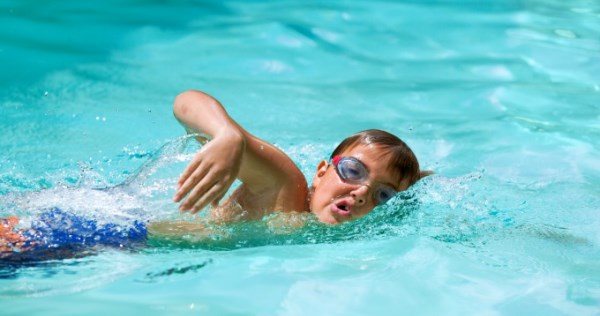
Classic crawl: inhale and then lower your face into the water
As mentioned above, a baby at this age will not immediately master the crawl or breaststroke, but the basic principles need to be laid from the very beginning.
Why is it wrong to swim with your head up?
- This leads to improper body balance and interferes with buoyancy and gliding.
- For the above reason, it is much more difficult to teach . The child will quickly learn to float on the water with his face lowered into it, but will drown if he keeps his head up all the time.
- It's unhealthy . For children this is not so important, but in general, a raised head is an excessive load on the cervical vertebra and pressure on the blood vessels. But the benefit of swimming lies in something else – in removing the axial load from the spine, in stretching.
You can read more about what kind of swimming is correct here.
Accordingly, a young child should first of all be taught the following:
- put your face in the water,
- exhale
- stretch out completely (with your head down),
- stretching out, push off and glide through the water,
- stretched out, swim using your legs (in the initial stages - with a swimming board).
Let me remind you once again that for 3-5 years old everything should be done in a playful and positive way. Tasks should be alternated so that the child finds it interesting and fun. If a task doesn’t work out or you don’t like, remove it or try to think of something to replace it with. Therefore, the following can be taken as a sample, but you should not consider this as the only possible program - look at the situation, experiment.
We teach a child to dive at 2 years old
It doesn’t matter if you can’t teach diving before 3 months. You can teach your child to dive underwater later. Based on conscious practice, repetition (without instincts). What is needed for that?
In order not to be afraid to put your face under water, they play the game “Blowing Bulbs”. An adult goes into the pool with a child and shows him how to blow air under water with his mouth, while “gurgling” (making bubbles). The face is lowered into the water to eye level, air is blown out through the mouth. If the child is afraid, offer to hold his nose with his fingers. Over time, he will relax, stop being afraid, and there will be no need to hold his nose.
Then you can compete: who can blow the most bubbles, who can make the water boil harder, or who can blow underwater longer. And this is the beginning of breath-holding training.
After a few days or lessons, when your baby becomes accustomed to blowing air underwater, move on to the next play exercises. We offer unique role-playing games - “dolphins” and “fish”. The game session begins with the words: “Fish or dolphins do not swim in the water with their faces up. They put him under water. Let’s be real fish and put our faces under the water.”
First, the face is lowered under the water for a short time (the child has already developed the breath-holding reaction). When a face appears from the water, they say “Oops!” or “Yes!” (at your discretion). After a few days or a week, the duration of diving is gradually increased.
The next game that teaches a child to hold his breath is splashing water. All children on the seashore are addicted to this game. Splashing warm sea water on each other, they have fun and learn to hold their breath. This skill will be needed for subsequent diving and swimming.
First steps - getting used to water
If we are talking about a very young child, then the very first step is getting used to water . Let your son or daughter get acquainted with it first - sit, stand in it, play with toys.
In this regard, it is very important to carry out habituation and initial training where:
- very shallow (where the child is waist-deep);
- clear warm water, preferably 27-28 degrees;
- water should not hurt your eyes.
The best option is a shallow pool with warm water.
The sea is undesirable due to waves, salty and colder water. Rivers and lakes are undesirable because they require a clear environment.
Not all young children enjoy being in the water, so be patient and let him do it the first time without any tasks, exercises, swimming goggles, etc. just an opportunity to play enough in warm, shallow, clear water and fall in love with it .
Water toys , watering cans, balls, and toys from favorite cartoons for developing interest in very young children
You can also arouse interest by watching cartoons and videos on a marine theme.
Swimming glasses
You need to get your child used to wearing swimming goggles. In children five years old this usually does not cause problems; in younger children, whims may arise at this stage.
Try to go through this stage in a playful way. Admire your child when he wears glasses. Explain and show that you can have fun and splash in them. Show by personal example.
If possible, it is also better to choose the glasses themselves in an interesting shape or color, but first of all they should not leak - I wrote in detail about how to choose them correctly here.
You can, of course, do without glasses at all - but then you need to choose a pool in which, if you are under water with your eyes open, there will be no unpleasant sensations in your eyes (check this for yourself first).
Water activities
Children's pools in Moscow are located not only in or in specialized centers aimed at pregnant women and infants. Water entertainment for children is available in water parks and other places where such a service is considered appropriate. In the summer, everyone is helped out by inflatable structures, which can be found in parks, on beaches or installed on your own plot of a summer house or home.
The children's pool offers many options) is replete with a variety of shapes and is suitable for children up to 6-7 years old. For older people, “real” water park slides become more interesting. You can purchase a swimming pool with a slide at a large supermarket, sporting goods store or online store. The choice is large and varied - from a standard multi-colored slide to complex designs with figures of dinosaurs, animals or castles. The cost starts from 2000-2500 rubles. The final cost depends on the material of manufacture and the ornateness of the design.
Putting your face in the water
- The very, very beginning is to simply wash your face with water or splash it.
- Squats and jumping in water. The idea is that by squatting or jumping, your face will be immersed in the water.
For example, set the task to sit down and look at each other, or sit down and jump up. A more advanced option is to stick your tongue out at each other or make a grimace. In general, have fun, but in such a way that your head regularly ends up under water. - Collection of toys. Place the toys at the bottom where it is shallow (that is, you do not need to dive much), but you cannot reach them with your hand without diving your face. Come up with some kind of legend - let the child carry out a “rescue operation” or get treasures.
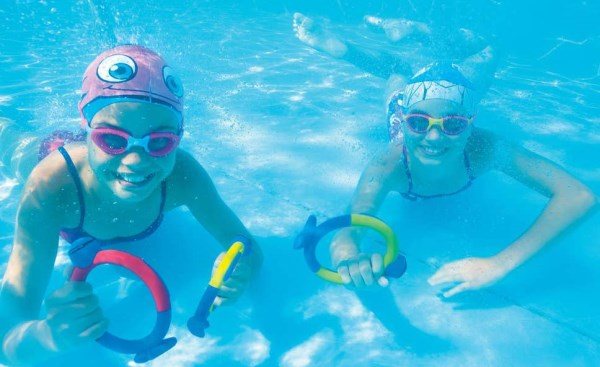
Collecting toys is a great game!
Exhalation
The next basic skill that a child must master is the ability to exhale into the water , since in proper swimming, regardless of style, this is how exhalation is done.
The academic version of teaching this, which is used by many trainers:
- holding the edge of the pool with your hands, lower your head and blow bubbles with your nose (you can also use your mouth, but it’s important to learn to use your nose). Repeat this for several minutes until you get tired;
- take a swimming board in your hands and, holding it with outstretched arms, swim using your legs, lowering your face into the water to exhale and raising it to inhale.
Other options in a playful manner are to do the same jumping and squats, adding exhalation under water.
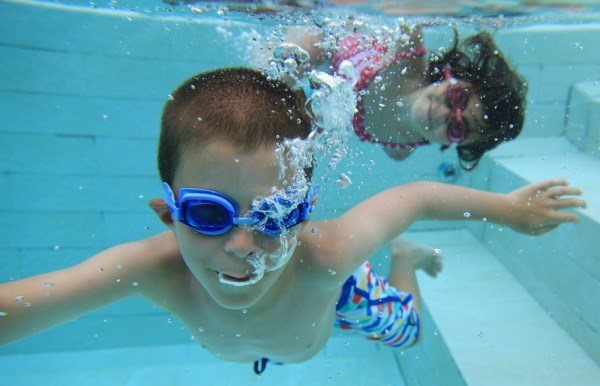
You can also exhale through your mouth, although it is better to learn to do it through your nose!
Slip
The goal is for the child to be able to slide in the pool , stretched out like an arrow. It is not necessary to breathe at first - you can do it while holding your breath.
Let me remind you that all exercises are done exclusively in the shallow part of the pool !
Let the child push off with his feet from the bottom or wall of the pool and slide , stretching his arms forward in front of him (“arrow”). At the end of the exercise, you pick him up, or he stands on the bottom himself.
This accustoms the body to the correct position in the water and teaches how to stay on it.
Footwork
The next stage is to connect the legs.
The academic option is to first teach how to work with your legs in the crawl style - that is, perform alternating swings up and down.
At the same time, some children are naturally closer to “frog kicks” rather than swings. Then there is no need to force them to do swings - let them work with their legs in a “frog style”.
To test which style your child is initially predisposed to, ask him to try swimming in any way and see how he intuitively begins to move his legs . This is shown in great detail and clearly in the video of trainer Denis Tarakanov, from whom I borrowed this idea:
If we are talking about the classic version (swing kicks, not frog kicks), then it makes sense to show the child their correct technique .
It is important to ensure that your legs do not bend too much at the knee. Small children intuitively begin to flop their legs, bending them at the knee - but instead the work should come from the hip - almost straight legs move up and down with the hip.
Read more about how your legs should move correctly in this article.
It is recommended that an adult first demonstrate the movements on land - we sit on the edge of the pool, stretch out our legs and move them up and down, then ask the child sitting next to him to repeat the same.
Then we go into the water, where there are two exercise options:
- The child pushes off with an arrow and slides towards you (as in the previous exercise), while connecting your legs.
First, we swim with our heads down while holding our breath (or exhaling).Then we learn to raise and lower our heads. I really like the exercises of Denis Tarakanov already mentioned above:
Raising the head – “thoughtful fish” -> “curious fish”:
Raising the head with an inhalation – “Thoughtful fish” -> “Admiring fish”:
- Exercises with a swimming board (if the first option does not work out).
The child picks up a swimming board and swims with it:- arms extended forward with board,
legs make swings,
- the head lowers to exhale and rises to inhale (don’t swim with your head up, otherwise nothing will work out later without a board).
It looks like this:
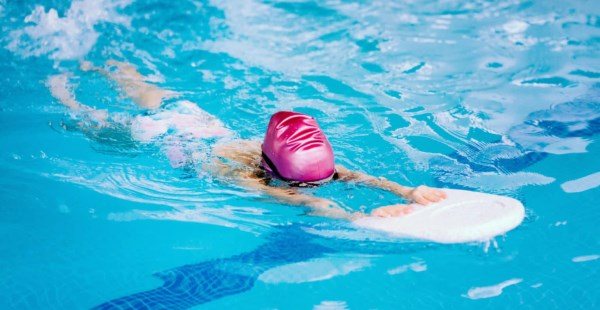
In general, this stage (learning to swim with your head down using your legs) can take a long time - be patient. The smaller the baby, the more practice it will take to learn these skills. For example, at 3 years old you can spend six months, or even a year, practicing this kind of swimming - your son or daughter will need time to gain a foothold at this level.
Do this until the child can swim at least some distance without a board (hands with an arrow) using only his legs.
Preschoolers
Older children can visit the pool and practice swimming starting from 4 years old. Please note that if your child is accepted into the section before this age, then most likely the coaches want to expand their client base, and not teach the children to swim correctly.
Please note that training for children must be of high quality, especially at the beginning, when basic skills are being developed. Age does not matter here at all - it can be 4 years or 7 years. By the age of 10, such children will swim at the same level, so even an experienced coach will not be able to guess at what age the child takes up swimming. The task of swimming professionals is to familiarize children with swimming skills, and not to overcome the distance “against the clock.” If you want your child to become a good swimmer years later, then send him to a vocational school with highly qualified coaches.
Connecting hands
Having gone through the previous stage, we next connect our hands.
The academic option is to learn crawl strokes with breathing to the side.
However, at a young age it is very difficult to master them; it is more realistic to make breaststroke movements with your arms :
- row with both hands towards yourself , at this moment the head rises above the water to inhale;
- throwing your arms forward , at this moment your head drops.
The correct technique for using your arms in breaststroke is described in this article, but you need to understand that for a child of 3-5 years old it will seem difficult .
In fact, very often children switch from breaststroke movements to doggy style swimming.
On the question of what to do about this, coaches have different points of view:
- some experts believe that it is necessary to achieve the correct breaststroke stroke technique, otherwise it will be difficult to instill it later;
- others believe that at the very first stage it is permissible for a child to learn to row at least somehow , even if like a dog. Thus, he will learn to at least somehow swim, and then it will be possible to use the correct technique.
From my point of view, a lot depends on the age, development and abilities of the child. I don’t see anything critical in the second option - first learn to at least somehow swim, then improve your technique.
To teach breaststroke strokes (even if in fact it will be “doggy style”), you need to show the child the movements first on land (asking him to repeat), then train them in the water.
If you decide or want to try to train your arms in the crawl style, then at first this is done by swimming with a board:
- as before, we swim with our feet,
- outstretched arms holding a board
- one of the hands makes a stroke and returns back to the board.
Professional opinion
Experienced coaches are inclined to the theory that it is better to send a child to a swimming sports section from the age of 7. During this period, the child develops self-discipline, organization of the working day and logic. However, by this age the child must have preparatory swimming skills in a children's pool. So it’s best to start teaching your child not to be afraid of water from the age of 4.
Let us note that children are most willing to study in a group, since by their nature they are inclined to team and team sports. Therefore, we recommend that you visit several swimming sections, introduce them to the children, the coaches, and give your child the opportunity to choose the team where he feels most comfortable.
In conclusion of our conversation today, I would like to note that the process of teaching your child to swim should be approached with all responsibility, since this sport cannot be called safe. And if your child is not eager to splash around in the water all day long, and you want to introduce him to physical education at all costs, then we strongly recommend that you abandon the idea of a swimming pool and choose another option for your child’s athletic development. Any activity your baby does should bring him not only benefit, but also pleasure, remember this!
Good luck to you!
About sleeves and vests
Armbands and swimming vests are insurance for a more relaxed swim on vacation, but they have nothing to do with learning to swim and, moreover, are harmful to it .
If you want your child to learn to swim, under no circumstances use any armbands or similar devices , as they upset the balance of the body and do not allow them to learn the most important thing - to float on the water.
At the same time, my three-year-old son swam during our vacation in oversleeves, it was easier and calmer, otherwise there would have been no rest. But this had nothing to do with swimming, and there was no such task at that time. The next year, I gave my son to the coach at the pool, and school was already underway there - of course, without sleeves.
Warm up and swim
A sauna with a children's pool (Moscow) is intended for family recreation. But according to reviews from visitors, such options are practically non-existent. Most of the complexes offer premises where a small plunge pool acts as a children's pool. The search should be directed to children's pools, which have a sauna with quickly adjustable temperature. An example of this would be the “Golden Fish” complex with several branches in different areas of the city, one of which has a sauna for children.
The swimming pool of the Nagornoye recreational center with a sauna is located near the Altufyevo metro station. Classes are conducted in groups or individually. In addition to water activities, there is a relaxation room with toys, a salt cave and warming up in the sauna after a fun time. The cost of a one-time visit is from 800 rubles for a half-hour session.
The pool + sauna service is offered by the children's health complex "Akvarelki" in the village of Nagornoye on the territory of the estate park. Trial lesson - 500 rubles, in the future you need to purchase a subscription (minimum 4 visits) at a price of 700 rubles per session.
The benefits of early learning to swim have long been convincingly proven by doctors. Pediatricians agreed that swimming in infancy and in slightly older children:
- improves blood circulation;
- develops the lungs and helps increase their volume;
- gives a hardening effect, so “floating” infants practically do not suffer from colds;
- has a beneficial effect on the development of the musculoskeletal system.
Features of teaching swimming to babies
The main condition is that learning should be enjoyable for the child. Therefore, game elements are constantly used during classes. A set of exercises is compiled for the baby, which should preserve and develop the innate swimming reflex that is initially present in every child, which gradually disappears by the third month of life. Therefore, if the time to start classes has been missed, and you have not decided to start teaching your baby to swim at such an early age, later they use a completely different method.
A child should not feel forced during swimming lessons. If he does not want to do some exercise or is tired of being in the water, you cannot insist on continuing the activity. Both the baby and his mother should receive only positive emotions from visiting the pool. Each lesson begins with gymnastics, for which approximately half the time is allocated - 15 minutes. This is followed by a fifteen-minute swimming session.
If you swallow water while swimming
At the very beginning of learning to swim, lowering his face, a child may, due to inexperience, swallow water , begin to choke, get scared and cry from this.
Your task at this moment is to react neutrally or neutral-positively, to transform the situation into a positive one.
The fact is that many parents either begin to scold their child, or at least react negatively or fearfully. A child who has already received unpleasant sensations from water in his nose and is frightened when he sees a parent swearing or frightened will make the following conclusion: “this should never happen again” and his desire to be in the water and learn will greatly decrease or disappear altogether.
Therefore, the main thing here is not to send even more negativity towards the child. Be indifferent or even positive (as far as possible and appropriate).
You need to calmly tell him to exhale forcefully through his nose and then all the water will go away.
Swimming lessons for preschool children from 5 years old
Swimming lessons for children 5 years and older will help raise a real champion, since it is at this age that children are accepted into professional sections. The child is now just beginning to understand that this is not just entertainment, but a serious sport. And if the child himself wants to engage in a sports section and participate in competitions, then it’s time to bring him to the pool. The number of lessons in the pool for children 5 years old should gradually increase from twice a week to five. In order for a young swimmer to be able to perform intense physical exercise, parents must understand that he must be provided with a nutritious, balanced diet.
5 years is the age when a child can also be sent to learn swimming from scratch. The swimming school provides classes both in a group (usually according to the level of training) and individual training. The child is under the constant supervision of a coach - small groups are formed so that all swimmers are given enough time and attention. Children who start learning to swim at this age quickly catch up with those who started learning at 2–3 years old.
Swimming lessons for children aged 7 to 9 years
Along with the first classes at a comprehensive school, a child can easily start swimming. Accordingly, from the second grade and older. At this time, he becomes more disciplined, which makes it easier for him to go to the pool. If you add effort to this quality, the child easily compares the coach’s tasks with the tasks of school teachers and quickly moves towards tangible results.
Additional equipment is usually not provided at this time, but everything depends on the child’s level of preparation and is decided individually by the coach.
The advantage of swimming in a pool from this age is that children begin to perceive information better. They can listen more carefully to the theoretical part of the classes, without being distracted from the instructor, which will improve both the quality of training and progression in learning.
Swimming pool for children from 9 to 12 years old
More professional training, which prepares young swimmers for sports competitions, begins on average at 9–12 years of age. The instructor complicates the teaching methods, developing the child's endurance and focusing on honing the techniques of swimming styles, which helps expand the young swimmer's theoretical knowledge along with skills in this sport.
To summarize, it is worth noting that you can start taking your child to the pool at different ages, depending on the wishes of the child and parents - just learn to swim and improve their health or start a sports career. Of course, the desire of the child himself is very important. A child’s desire to take up swimming can also be influenced by his coach, so choosing an instructor must be approached very carefully. When we love a teacher, then the children come to his classes with great pleasure. And this is a common success for the parents and the coach.

